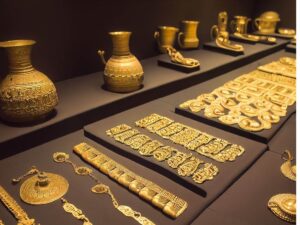1. The Historical Significance of Gold
Gold has always held a special place in history, evoking a sense of grandeur, power, and beauty. Since ancient times, gold has been cherished for its luster, rarity, and malleability. The historical significance of gold transcends mere ornamental use, intertwining itself with tales of power, religion, and wealth. Let’s explore these significance:
- Legacy of ancient civilizations: For the Egyptians, gold represented the sun god Ra and was often used to craft intricate jewelry and artifacts for the pharaohs and other nobility. The Romans saw gold as a symbol of wealth and status, bestowing it upon their emperors and generals. In the Americas, the Mayans believed gold to be the sweat of the sun, utilizing it in religious ceremonies and for adornment of their leaders.

- Religious connotations: In Christianity, for example, gold symbolizes divinity and is frequently used in religious artifacts. Buddhist temples, on the other hand, are adorned with gold, portraying it as a material of enlightenment and purity. Such associations have elevated gold’s status, making it the preferred metal for crafting objects of spiritual significance.

- Economic value and trade: Throughout history, it served as a universal currency, facilitating trade between diverse civilizations. It was not just a metal of luxury, but an essential commodity for commerce. Its intrinsic value, scarcity, and the challenge to mine it made gold a trusted medium of exchange and a store of value.

-
Cultural and artistic relevance: Across diverse cultures, gold has been a canvas for artisans and craftsmen. Its malleability allows for fine detailing, making it the first choice for artisans looking to create masterpieces that stand the test of time.
2. Physical Properties of Gold
Gold, with its radiant luster and unique characteristics, has firmly established itself as a primary material for jewelry-making. The allure of this metal is not only due to its inherent value or historical significance but also because of its distinct physical properties. Delving deeper into the characteristics of gold reveals why it has been the cornerstone of jewelry craftsmanship for millennia. Below are some of its defining features:
Luster and Color
The mesmerizing yellow hue and brilliant shine of gold sets it apart from many other metals. This natural luster is not fleeting; gold does not tarnish or corrode, ensuring that pieces crafted from it maintain their radiance for ages. The metal can also be alloyed with other elements to create various colors such as rose gold, white gold, and even green gold, offering versatility in jewelry design.
Malleability
One of gold’s most defining characteristics is its malleability. A single ounce can be stretched into a thin wire spanning miles or hammered into a sheet covering almost a hundred square feet. This extreme malleability allows craftsmen to mold, twist, and transform gold into intricate designs and patterns, making it a favorite for detailed jewelry pieces that demand precision.
Having held and observed countless gold pieces, it’s awe-inspiring to think of the artistic possibilities this metal offers to its craftspeople.
Ductility
Hand in hand with malleability is gold’s ductility. This property ensures that the metal can be drawn out into tiny wires without breaking. As a result, gold can be used in delicate threadwork, woven patterns, or to secure gemstones in settings. The ability to craft thin gold wires without sacrificing strength ensures that the resulting jewelry is both delicate in appearance and robust in structure.
Density and Weight
Gold is inherently dense, giving it a substantial weight and feel, which is often equated with luxury and opulence. When handling gold jewelry, this weightiness provides a sensation of quality and value. Despite its density, gold doesn’t feel cumbersome but rather imparts a sense of durability and timeless value to the jewelry.
Resistance to Corrosion
Gold’s resistance to most acids and its immunity make it incredibly resilient. Jewelry crafted from gold remains untarnished even when exposed to elements over time. This ensures that gold jewelry retains its appearance, making an excellent choice for heirloom pieces that pass through generations. The glow of a decades-old gold piece remains unmatched, evoking memories of the past while shining brilliantly in the present.
3. Symbolic Meanings and Cultural Relevance
Gold, beyond its physical allure and properties, has consistently captured the imaginations and hearts of civilizations throughout history. Its gleam has been associated with power, divinity, and wealth across different eras and regions. Delving into this, below are some symbolic meanings of gold:
- Wealth and prosperity: Its inherent value, combined with its scarcity, has made it a tangible representation of affluence. In various cultures, possessing gold signified not just monetary richness but also a prominence in societal hierarchy.

- Purity and divinity: Gold’s resistance to tarnish and corrosion has lent it a symbol of purity in many religious contexts. For example, in spiritual ceremonies and rituals, gold often represents the divine, untainted aspect of existence. Its incorruptibility parallels the concept of spiritual purity, leading to its extensive use in religious artifacts, places of worship, and ceremonial attire.
- Eternal love: Gold, with its timeless sheen, has also become emblematic of everlasting love and commitment. Be it in wedding rings or anniversary gifts, the use of gold signifies a bond that endures time’s challenges. The unchanging nature of gold mirrors the idea of an eternal bond, unyielding and unwavering in the face of life’s adversities.
- Power and leadership: From crowns to scepters, gold has always found its place in the regalia of leadership. Its association with the sun, emitting light and warmth, parallels the idea of a leader illuminating and guiding their people. Gold, in this context, underscores authority, guiding influence, and the responsibility of leadership.
-
Asian festivities: Festivals, weddings, and auspicious occasions often involve buying and gifting gold jewelry. It’s not just an investment but also a token of blessings, good luck, and prosperity, deeply embedded in cultural practices and traditions.

4. Economic Implications
Gold, a timeless treasure with deep roots in various cultures, also holds undeniable economic weight. This precious metal has played a pivotal role in the global economy for centuries, shaping trade routes, dictating currencies, and influencing monetary policies. Understanding gold’s economic implications offers deeper insights into its prevalence in the jewelry industry. Here’s a closer look:
Store of Value
Gold, unlike many other commodities, retains its value over long periods. Its scarcity, combined with its demand in various industries including jewelry, ensures that it remains a sought-after asset. In times of economic instability or inflation, many turn to gold as a hedge, given its relatively stable value.
This unique position in the financial landscape makes it a reliable and tangible store of value, further enhancing its appeal in the jewelry sector.
Trade and Exchange
Before modern currency systems, gold coins or bullion often served as a universal medium of exchange. The weight and purity of gold made it a trusted and neutral currency, paving the way for international trade relations. Rexjewel, as a reputable jewelry manufacturer, continues to harness this trust by using only the finest gold in crafting exquisite pieces.
Today, while direct gold trade has reduced, it still influences foreign exchange reserves and trade balances, with its demand in the jewelry industry playing a significant role.
Employment and Skill Development
The mining, refining, crafting, and retailing of gold jewelry offer employment to millions globally. From artisanal miners to skilled jewelers, the gold value chain provides livelihoods and promotes skill development. Moreover, the jewelry industry fosters artistry, craftsmanship, and innovation. By maintaining a high demand for gold jewelry, the industry indirectly supports economic growth and job creation in various regions.
Monetary Policies and Reserves
As per The Times of India, the demand and pricing of gold, driven in part by its utilization in jewelry, can impact interest rates and other key economic decisions. Central banks around the world hold significant gold reserves, which influence monetary policies and financial stability.
|
Aspect
|
Description
|
Economic Implication
|
|
Demand and Pricing
|
The price of gold often reflects economic conditions, including inflation, deflation, and financial crises.
|
Central banks might adjust interest rates or liquidity provisions based on gold prices to manage inflation and overall economic stability.
|
|
Gold Reserves
|
Central banks hold gold as a part of their international reserves.
|
The amount of gold reserves can serve as a buffer against economic downturns, providing a source of liquidity in times of financial crises.
|
|
Monetary Policy Influence
|
The price and demand for gold can signal potential inflation or economic downturns.
|
Central banks might adopt preventive or corrective monetary policies based on these gold-driven indicators to ensure economic stability.
|
|
Currency Valuation
|
Countries with large gold reserves can see a positive impact on their currency’s value.
|
A strong currency can make imports cheaper and stabilize the domestic economy, but it might also impact the competitiveness of exports.
|
|
Financial Stability
|
Gold often acts as a “safe haven” asset, attracting investments during economic instability.
|
During economic downturns or crises, a country with significant gold reserves can navigate challenges more comfortably, ensuring more substantial financial resilience.
|
Gold serves as a safety net, providing assurance in times of economic downturns or crises. Gold’s role extends beyond adornment, shaping the economic strategies of nations.
5. Aesthetic Qualities
Gold, with its resplendent glow, has charmed generations with its beauty and brilliance. When one thinks of luxurious jewelry, the allure of gold often stands at the forefront. Beyond its economic or symbolic importance, gold’s aesthetic qualities make it a preferred choice in the jewelry world.
Delving deeper into these qualities offers a comprehensive understanding of its timeless appeal. Let’s explore the facets that contribute to this allure:
Lustrous Shine
Gold’s inherent gleam sets it apart from many other metals. This lustrous shine is not just about the metal’s radiant color but also its ability to reflect light in a manner that accentuates its richness. Over time, while some metals may lose their sheen or become dull, gold retains its brilliance. This unparalleled luster ensures that any jewelry piece made of gold stands out, making it a favorite for those seeking to make a statement.
Versatility in Color
While the classic yellow gold is universally recognized, gold’s versatility extends to various hues like white gold, rose gold, and even green gold. These colors emerge from alloying gold with other metals. For instance, blending gold with copper yields the romantic hue of rose gold. This range of colors broadens the design possibilities, allowing jewelers to craft pieces that cater to diverse aesthetic preferences.
Compatibility with Gemstones
Gold’s unique color profile complements a plethora of gemstones, from sparkling diamonds to vivid emeralds or deep sapphires. When set in gold, these gemstones appear more vibrant, and their colors pop, creating a harmonious blend of shine and hue. This compatibility ensures that gold remains the metal of choice for settings in high-end jewelry, highlighting the brilliance of both the metal and the gem.
Malleability and Design Flexibility
One of gold’s defining aesthetic qualities is its malleability. According to Portland Gold Buyers, this means it can be shaped, molded, and crafted into intricate designs without losing its inherent beauty. From delicate filigree work to bold, contemporary structures, gold’s flexibility as a material is unparalleled. It allows for the realization of intricate designs, patterns, and motifs, catering to a wide array of stylistic choices.
Timelessness
Gold’s appeal isn’t fleeting. While fashion trends come and go, the allure of gold remains consistent, making it a staple in heirloom pieces and contemporary designs alike. At Rexjewel, this understanding drives the timeless designs crafted, ensuring every piece resonates with this ageless allure.
In my years as a jewelry expert, I’ve always marveled at how gold pieces, regardless of their age, never lose their charm. Its timelessness ensures that a gold jewelry piece remains relevant, appreciated, and admired across generations.
Dive Deeper Into Our Resources
Looking for more diverse product options? Browse through our handpicked selections:
For some insightful reads, we’ve curated a list of recommended articles just for you:
Still haven’t found what you’re looking for? Don’t hesitate to contact us. We’re available around the clock to assist you.
Conclusion
Gold’s unyielding charm transcends time, cultures, and trends, cementing its place as the quintessential choice for jewelry. Its rich history, aesthetic brilliance, and multifaceted significance make it an emblem of luxury, tradition, and artistry, captivating hearts for generations.
For those in pursuit of the finest gold jewelry, Rexjewel stands as a beacon of craftsmanship and quality. Trust in the legacy of gold and transform it into a piece that speaks volumes. To embark on this golden journey, don’t hesitate to contact us for more information.










